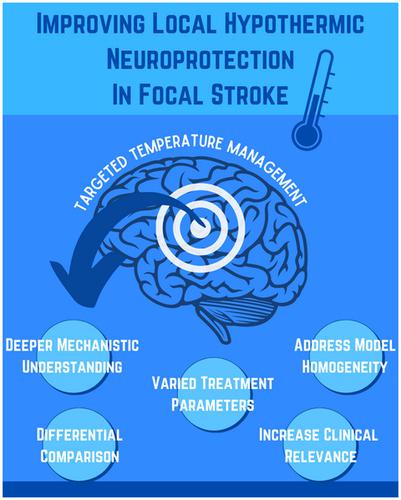当前位置:
X-MOL 学术
›
J. Neurochem.
›
论文详情
Our official English website, www.x-mol.net, welcomes your feedback! (Note: you will need to create a separate account there.)
Targeting focal ischemic and hemorrhagic stroke neuroprotection: Current prospects for local hypothermia
Journal of Neurochemistry ( IF 4.7 ) Pub Date : 2021-09-08 , DOI: 10.1111/jnc.15508 Lane J Liddle 1 , Anna C J Kalisvaart 1 , Ashley H Abrahart 1 , Mohammed Almekhlafi 2 , Andrew Demchuk 2 , Frederick Colbourne 1, 3
Journal of Neurochemistry ( IF 4.7 ) Pub Date : 2021-09-08 , DOI: 10.1111/jnc.15508 Lane J Liddle 1 , Anna C J Kalisvaart 1 , Ashley H Abrahart 1 , Mohammed Almekhlafi 2 , Andrew Demchuk 2 , Frederick Colbourne 1, 3
Affiliation

|
Therapeutic hypothermia (TH) has applications dating back millennia. In modern history, however, TH saw its importation into medical practice where investigations have demonstrated that TH is efficacious in ischemic insults, notably cardiac arrest and hypoxic-ischemic encephalopathy. As well, studies have been undertaken to investigate whether TH can provide benefit in focal stroke (i.e., focal ischemia and intracerebral hemorrhage). However, clinical studies have encountered various challenges with induction and maintenance of post-stroke TH. Most clinical studies have attempted to use body-wide cooling protocols, commonly hindered by side effects that can worsen post-stroke outcomes. Some of the complications and difficulties with systemic TH can be circumvented by using local hypothermia (LH) methods. Additional advantages include the potential for lower target temperatures to be achieved and faster TH induction rates with LH. This systematic review summarizes the body of clinical and preclinical LH focal stroke studies and raises key points to consider for future LH research. We conclude with an overview of LH neuroprotective mechanisms and a comparison of LH mechanisms with those observed with systemic TH. Overall, whereas many LH studies have been conducted preclinically in the context of focal ischemia, insufficient work has been done in intracerebral hemorrhage. Furthermore, key translational studies have yet to be done in either stroke subtype (e.g., varied models and time-to-treat, studies considering aged animals or animals with co-morbidities). Few clinical LH investigations have been performed and the optimal LH parameters to achieve neuroprotection are unknown.
中文翻译:

针对局灶性缺血性和出血性卒中神经保护:局部低温的当前前景
治疗性低温 (TH) 的应用可以追溯到几千年前。然而,在现代历史中,TH 被引入医疗实践,研究表明 TH 在缺血性损伤中有效,特别是心脏骤停和缺氧缺血性脑病。同样,已经进行了研究以调查 TH 是否可以为局灶性卒中(即局灶性缺血和脑出血)提供益处。然而,临床研究在中风后 TH 的诱导和维持方面遇到了各种挑战。大多数临床研究都试图使用全身冷却方案,但通常会受到可能恶化中风后结果的副作用的阻碍。使用局部低温 (LH) 方法可以避免全身 TH 的一些并发症和困难。其他优势包括可能实现更低的目标温度和更快的 LH 诱导率。本系统评价总结了临床和临床前 LH 局灶性卒中研究的主体,并提出了未来 LH 研究需要考虑的关键点。我们总结了 LH 神经保护机制的概述,并将 LH 机制与全身 TH 观察到的机制进行了比较。总体而言,虽然许多 LH 研究是在局灶性缺血的情况下进行的临床前研究,但在脑出血方面所做的工作还不够。此外,尚未对任一中风亚型进行关键的转化研究(例如,不同的模型和治疗时间,考虑到老年动物或有合并症的动物的研究)。
更新日期:2021-09-08
中文翻译:

针对局灶性缺血性和出血性卒中神经保护:局部低温的当前前景
治疗性低温 (TH) 的应用可以追溯到几千年前。然而,在现代历史中,TH 被引入医疗实践,研究表明 TH 在缺血性损伤中有效,特别是心脏骤停和缺氧缺血性脑病。同样,已经进行了研究以调查 TH 是否可以为局灶性卒中(即局灶性缺血和脑出血)提供益处。然而,临床研究在中风后 TH 的诱导和维持方面遇到了各种挑战。大多数临床研究都试图使用全身冷却方案,但通常会受到可能恶化中风后结果的副作用的阻碍。使用局部低温 (LH) 方法可以避免全身 TH 的一些并发症和困难。其他优势包括可能实现更低的目标温度和更快的 LH 诱导率。本系统评价总结了临床和临床前 LH 局灶性卒中研究的主体,并提出了未来 LH 研究需要考虑的关键点。我们总结了 LH 神经保护机制的概述,并将 LH 机制与全身 TH 观察到的机制进行了比较。总体而言,虽然许多 LH 研究是在局灶性缺血的情况下进行的临床前研究,但在脑出血方面所做的工作还不够。此外,尚未对任一中风亚型进行关键的转化研究(例如,不同的模型和治疗时间,考虑到老年动物或有合并症的动物的研究)。

























 京公网安备 11010802027423号
京公网安备 11010802027423号